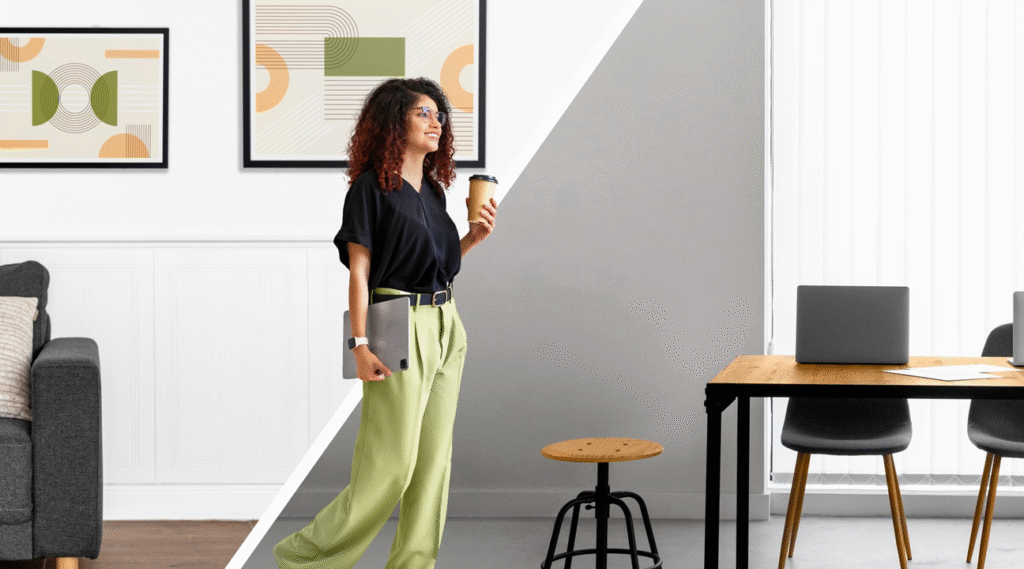For a generation that demands speed, style, and uniqueness in their spaces, Room Makeover AI has quickly established itself as a particularly creative solution. Beautiful room transformations, once the domain of elite interior designers, are now easily accessible thanks to platforms like RoomGPT, RoomAI, and REimagineHome. Each of these platforms offers a set of incredibly effective tools that can redesign a space more quickly than a streaming service waits for your next series binge.
Homeowners and real estate agents alike are increasingly depending on Room Makeover AI for incredibly successful and photorealistic redesigns, driven by a desire for immediate results. The fact that RoomGPT alone has over two million users and produces over 24 million designs makes it abundantly evident that this technology is having a significant impact. Similarities to the early adoption craze for apps like Instagram and Canva, which both fundamentally changed their respective industries, have been made in recent months.
Room Makeover AI Platform Overview
| Attribute | Details |
|---|---|
| Platform Names | RoomGPT, AI Room Planner, RoomAI, REimagineHome, Canva Interior AI, RoomsGPT |
| Launch Period | 2022–2023 (early boom phase) |
| Primary Function | Virtual interior design, virtual staging, landscaping, exterior rendering |
| Notable Achievements | 2M+ users (RoomGPT), 24M+ designs created, 300M+ social media video views |
| Pricing | Free trials available; premium plans from $7/month (RoomGPT special offer) |
| Target Audience | Homeowners, real estate agents, photographers, interior designers |
| Reference Link | Visit RoomGPT.io |
Room Makeover AI is more than just a tool; it represents a bridge to a more approachable kind of creativity by simplifying design decisions and providing beautiful, ready-to-implement visualizations. It has become almost as commonplace as adding a filter to a selfie to upload a single photo, choose a favorite style, and see an entire room transformed. These AI tools effortlessly manage layers of complexity behind the scenes, providing users with polished, expertly curated outputs, much like a swarm of bees working in unison.

As curated room tours proliferated on social media sites like Instagram and TikTok, Room Makeover AI’s impact significantly grew. The need for visually appealing spaces increased dramatically during the pandemic, when homes served as sanctuaries, gyms, and offices. Even taste-makers trust technology, as evidenced by the fact that celebrities like Emma Chamberlain and Dakota Johnson, who were both commended for their unique home designs in Architectural Digest features, reportedly used AI renderings to generate layout ideas.
Platforms like REimagineHome provide a glaringly obvious edge by offering exterior landscaping services in addition to interior landscaping, serving both homeowners and realtors looking to sell more quickly. At a speed that traditional methods can scarcely match, the platform offers a comprehensive vision by incorporating rapid virtual staging, clearing cluttered spaces, and creating virtual gardens. These businesses have greatly expanded their reach and increased the appeal of the real estate market globally by forming strategic alliances with realtors and photographers.
The popularity of Room Makeover AI is largely due to affordability. In the past, it could easily cost thousands of dollars to hire a designer for just one room. In contrast, a RoomGPT membership starts at a surprisingly low $7 per month. Users can create as few or as many designs as they need thanks to a flexible credit system, greatly increasing the accessibility of high-end interior transformation.
There has been a noticeable change in real estate marketing during the last two years. Agents are producing dramatically staged listings without the logistical hassles of physical staging by utilizing Room Makeover AI. Virtually staged homes sell 88% faster and fetch up to 20% higher offers, according to research from Home Staging Resources. This shows how effective visual appeal has become.
AI-assisted design is on the rise, which is indicative of a larger cultural shift that values uniqueness and personalization. Interior design is shifting toward quick, adaptable updates, much like fashion has embraced quick seasonal changes and limited-edition capsule collections. Inspired by the constantly shifting aesthetics of social media, homeowners are now updating their spaces seasonally, even monthly, rather than sticking to a single look for years.
Renovation of a Room The effects of AI on society go beyond practicality. These platforms encourage a more subdued form of sustainability by drastically lowering the environmental impact typically linked to material waste, impulsive decor purchases, and furniture returns. Customers make fewer but better purchases by virtually previewing and improving designs—a remarkably successful tactic for eco-conscious living.
It makes sense that industry insiders are worried about how the technology might challenge conventional interior design methods. But discussions among top design firms point to a more promising future. AI is seen as a powerful extension of human creativity, not a replacement for it. It streamlines mood boarding, makes client collaboration easier, and frees up designers to concentrate on conceptual innovation.
The competition to create ever-more-advanced tools has accelerated in recent years. Even small startups can now incorporate sophisticated room visualization features straight into their apps thanks to the expansion of companies like Spacely AI and RoomDesigner AI into providing API solutions for businesses. For customers, this portends a time when virtual room makeovers may be easily combined with online furniture or real estate browsing.
The psychology underlying Room Makeover’s appeal AI is straightforward but profound: people want to have control over their surroundings. In times of uncertainty, altering a physical space provides a tangible demonstration of change’s potential and a sense of agency. AI platforms remarkably satisfy that emotional need by providing quick, adaptable, and attractive transformations.
Room Makeover AI is already an essential component of early adopters’ creative toolkit. Veterans of the field see it as a turning point that promotes cooperation between machine efficiency and human intuition. It appears highly probable that in the upcoming years, AI will not only make layout recommendations but may develop into completely immersive design advisors that incorporate VR and AR technologies to offer walkthrough experiences before a single nail is driven.

